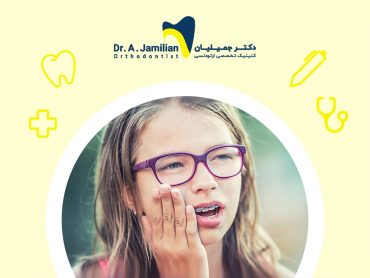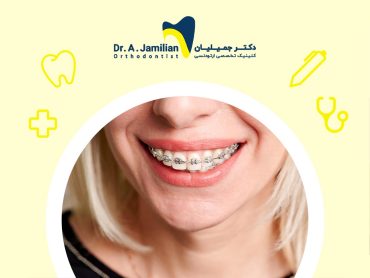The most important question people have before starting treatment for dental braces is how long this treatment will take. It should be considered that installing orthodontic devices, commonly known as dental braces, is a relatively quick procedure. However, the duration of these devices on the teeth, or the orthodontic treatment period, takes longer. The orthodontic specialist will initially explain this duration after conducting the necessary examinations and assessing the severity of the dental issues or abnormalities. It is essential to note that since the physiology of different individuals responds differently, an orthodontist does not specify an exact completion time of orthodontic treatment and provides a minimum and maximum duration. Consulting with a contemporary and up-to-date orthodontic specialist can ensure a well-structured treatment plan, allowing you to start your orthodontic care confidently.
Difference between the duration of braces installation and orthodontic treatment period
To state the difference between the duration of braces installation and the overall length of orthodontic treatment and to understand them, it is necessary to provide clear definitions of both procedures mentioned above.
The duration of braces installation refers to the time an orthodontic specialist spends to install the orthodontic brackets on the teeth. Once patients visit the orthodontist, the treatment process begins, and radiographic evaluations and examining the teeth’s condition are essential. Undoubtedly, the more misaligned the teeth are, the longer it takes to install the brackets. The orthodontic specialist spends 30 to 45 minutes installing the orthodontic brackets.
The duration of orthodontic treatment refers to the time during which the brackets remain on a person’s teeth to achieve proper alignment. Generally, orthodontic brackets might stay on the teeth for one to three years. The more misaligned the teeth are, the longer the orthodontic treatment will take so that all deficiencies are fully corrected.
In the following sections, we will discuss the factors influencing the duration of installing braces and the overall orthodontic treatment period in more detail.
Factors affecting the duration of braces installation
Before starting braces installation, the orthodontist performs necessary examinations to determine the best method for treating the patient’s dental and jaw abnormalities. In some cases, patients may have misaligned not only their teeth but also their jaws. However, a skilled orthodontist with a fellowship in surgery can treat both conditions. During the initial examination, necessary radiographs of the mouth and teeth are taken. The sooner the assessment is conducted, the shorter the duration of braces installation will be.
The orthodontist must ensure the health of the patient’s teeth before attaching braces. Braces should not be installed on decayed teeth until they are treated. Therefore, dental decay treatment is performed first, followed by orthodontic treatment, which impacts the overall duration of braces installation.
The time required to attach the brackets depends on the degree of dental misalignment, the size of the jaw, and other factors. As the severity of the patient’s dental/jaw malocclusion increases, the longer the braces installation will take. This is due to the installation of brackets requiring greater precision, and the orthodontist must proceed more slowly to ensure precision. Indeed, the type of braces affects the duration. Lingual braces (attached to the back of the teeth) take longer to install than traditional braces (attached to the front).
Factors affecting the duration of orthodontic treatment
The duration of orthodontic treatment and the impact of starting treatment at different ages is one of the critical factors in understanding the effectiveness of orthodontics. The treatment duration depends on various factors, such as the type and severity of dental and jaw abnormalities, as well as the patient’s age. We will briefly address all these factors later. However, on average, orthodontic treatment with braces takes about two years, and in some cases, it might last several years. Understanding these factors can assist individuals achieve their goals with minimal costs and without surgery. Through orthodontic treatment, individuals can achieve aligned, beautiful, and healthy teeth and jaws. Not to mention the benefits of proper and easier chewing.
1- Severity of jaw abnormalities
The duration of orthodontic treatment might vary based on the degree of dental misalignment, the size of the jaw, and jaw deviation. More severe irregularities or a smaller jaw require a more extended treatment period. For these individuals, a longer duration is necessary to align the jaw and teeth compared to individuals with minor dental abnormalities.

2- Patient’s age
Another significant factor affecting the duration of treatment for dental braces is the patient’s age. At younger ages, due to the softer bone tissue, faster tooth movement is allowed, which reduces the time needed for braces. Orthodontists recommend starting treatment during childhood, adolescence, or before the end of puberty. This article suggests that parents should take their children’s orthodontic needs seriously and address them before adulthood, as the treatment is generally shorter and more effective at younger ages.

3- Type of orthodontic treatment
The type of orthodontic treatment significantly affects the duration of the process. One of the advantages of dental braces with fixed orthodontic brackets is that the duration is shorter compared to removable orthodontic appliances. Therefore, with careful adherence to all recommended precautions during this period, you can achieve faster and more effective results from orthodontic treatment, bringing you closer to your desired smile more quickly. Alternatively, the type of braces employed in fixed orthodontic treatment impacts the duration of dental braces. However, you cannot request that the orthodontist select the fastest treatment method, as the condition of the teeth, jaw alignment, and severity of the malocclusion are the most critical factors in determining the most appropriate orthodontic treatment approach.
4- Patient’s care of orthodontic appliances
Success in orthodontic treatment and accelerating the treatment process can only be achieved through cooperation between the patient and the orthodontist. The patient must adequately care for the orthodontic appliance. For instance, consuming hard foods and snacks is one of the most common mistakes patients make, as it puts pressure on the braces and wires. Not only slows down the treatment process by bending the wires but potentially causes the brackets to detach. Such issues prolong the duration of orthodontic treatment because the patient requires a visit to the orthodontist to have new brackets installed.

5- Oral and dental hygiene
When orthodontic brackets are applied to a patient’s teeth, flossing and brushing become challenging. Inadequate oral hygiene can damage gum tissue and lead to oral diseases, which will prolong the orthodontic treatment period. The patient must carefully and patiently clean their teeth at least three times a day. Using orthodontic-specific toothbrushes and dental floss is essential to maintaining dental health and ensuring a shorter duration of braces.
6- Medications used during orthodontic treatment
It is noteworthy that certain medications can affect the duration of orthodontic treatment by decreasing the rate of tooth movement. For instance, immunosuppressive drugs like acetaminophen, aspirin, and similar medications can decelerate the movement of teeth. Conversely, some medications, such as vitamin D, can enhance the rate of tooth movement, thereby reducing the overall duration of orthodontic treatment. For a comprehensive understanding of medications that impact orthodontic treatment, refer to the article “Effects of medications on orthodontic treatment.”
Comparison of orthodontic treatment duration between children and adults
Initiating orthodontic treatment at an optimal age significantly affects the duration and success of the treatment. If orthodontic interventions, such as braces, are not employed to move and correct the jaws at the appropriate age, it becomes challenging to achieve effective results as the bones harden with age. In adults, this often necessitates surgical procedures to address jaw issues. Surgery not only leads to significantly higher costs but involves considerable risks and complications for the patient, affecting the overall duration of orthodontic treatment. In younger patients, where the jawbone is still pliable, orthodontic devices can apply gentle forces to move and align the jaw effectively.
For instance, physicians often recommend swimming to children to promote height growth as the targeted bones become longer and more well-formed. This process facilitates the lengthening and improved shaping of the targeted bones. Similarly, the use of orthodontic devices to guide the growth and form of the jawbone adheres to the same principle. The pliable and developing bones of a child can be molded into the desired shape and form at a young age by applying precise and measured forces to achieve the desired force and shape.
Duration of Orthodontic Treatment FAQ
The duration of orthodontic treatment can be shortened with the patient’s cooperation in attending scheduled appointments regularly, maintaining proper oral hygiene, particularly during the night, adhering to the orthodontist’s instructions, and avoiding actions that could disrupt the treatment process, which significantly contributes to the progress and reduction of the overall treatment duration.
If your orthodontist has recommended the use of elastics, it is essential to wear them as directed, except during meals. This practice facilitates faster tooth movement and alignment. Consequently, elastics should be worn for a minimum of 22 out of 24 hours each day to ensure optimal results. However, it is important to consult with your orthodontist. Different individuals will have different requirements, and usage rates, and the duration will differ.
The duration of orthodontic treatment varies for each patient and is determined by factors such as the type and severity of the malocclusion. Orthodontists can give a more precise estimate after conducting a comprehensive examination of the patient.
Yes, orthodontic treatment is typically faster and easier for children compared to adults. Jaw shaping is considerably more straightforward and effective at a younger age, and there is no need for surgical intervention. However, there is no age limitation for starting orthodontic treatment, and adults can also benefit from the advantages of orthodontic care, similar to children.







